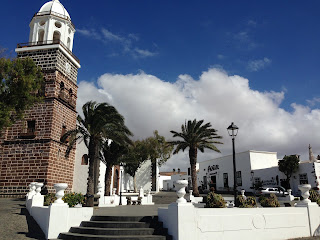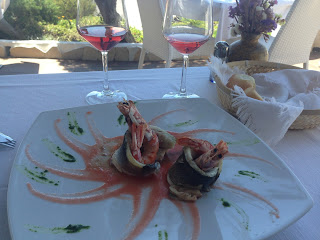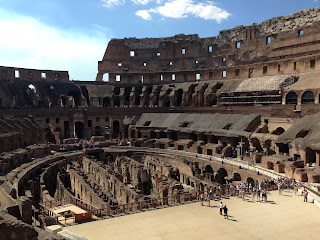We decide that we could wait until he was a fully functional unit again, or beat it as fast as we could to Cape Verde before the heavy winds set in according to the forecast. But we had to go the next day. And if he got better and the winds didn't get up too much, we would just turn right and go for it all the way to the Caribbean without stopping. We felt 2-1/2 months in Puerto Mogan was enough, but we could sit in the marina until the forecast was better or sit on the boat making way, at least cutting a week out of our journey across the Atlantic. So, we checked out and made way the next morning.
 |
| Bye bye to Puerto Mogan, Gran Canaria |
About day 3 the winds filled in the right amount and we had the spinnaker up for the day and most of the night. About 5am the winds got up a bit too much (20+ knots) and we were on the edge of being over powered so pulled it down, just in time. It was a great sail while it lasted as that sail makes for a very smooth steady ride.
And so the winds continued to build as the forecast said and soon it was blowing 25-30 and seas were getting up, like 2-3 meters, and a bit confused. Our smooth ride turned a bit "sporty" and we had to just hang on. We got the Geny poled out and main prevented so we were wing-on-wing which scooted us along nicely. But in a sloppy sea, we rolled our way along. Try sleeping in a boat that rolls from rail to rail, like an old rickety train ride.
Eventually we found a spot we could set the sails for a broad reach and land us in the Cape Verde islands instead of Brazil. :) Broad reaching is a smoother sail than wing-on-wing (in confused seas), which was welcome as the seas continued to build, 3-4 meters now and the winds occassional hitting 35 knots, apparent (40 knots true). These are near Gale conditions, but at least it was behind us. The autopilot was a trooper, never missed a beat. But we were watching it every mile for the last day, hoping the conditions wouldn't get any worse and keeping the boat moving so we could get in before dark on the 5th day. And sure glad we did as the harbour is a bit of a mess, sunken boats, etc.
After an hour of trying to get the anchor set (lots of foul ground, bags, ropes, etc.), we gave up and headed for the marina. And so they put us in a spot down wind of the dock (by now 10pm) and we were set for the night. A much needed shower, some food and to bed, in flat water, finally!
So, 840 miles later, 5 days and 11 hours (that's 6.4 knots average, including the slow start, which is fairly fast for EQ), salt encrusted, we'll take a rest, finish coughing up yellow goo, and let the weather gods send us a fair wind. There's an enormous high pressure system building (1045) which will boost the trade winds to gale conditions, so we'll wait for that all to settle down before venturing further.
So, that's the news from EQ, where the winds are a bit blustery, the seas still sporty, and the marina a bit rickety with 30+ knot gusts, but the crew content to rest. And of course we are happy to have flying fish land in the cockpit so we know we are in tropical waters again, not to mention heaps of dolphins joining in the fun. I must also add that Kim has been a real joy to sail with, she's a true sailor to the marrow.
With Equanimity and Joy...


















































